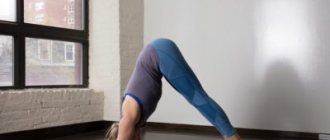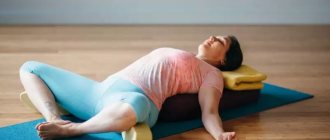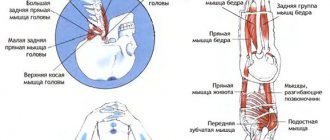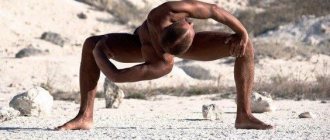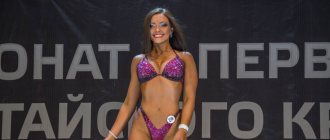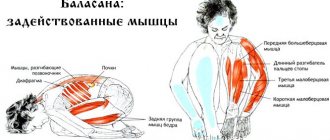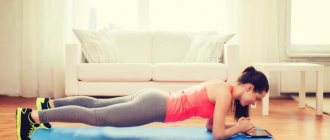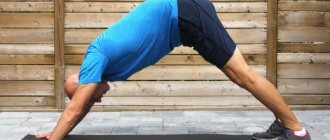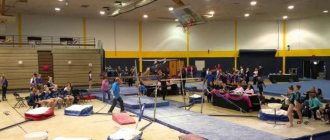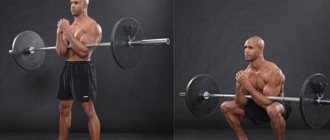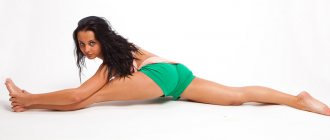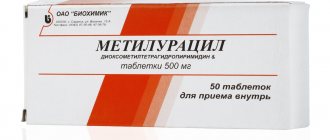Vrikshasana translated from Sanskrit means “tree pose.” This asana is suitable for beginner practitioners. The pose stretches the spine and provides relief from back pain, and also develops the muscles of the legs. The asana ventilates the lungs well. After practicing tree pose, you feel lightness in the body, stability and self-confidence. This asana is also used in qigong due to the fact that its basis is peace and relaxation.
Execution technique
- Get into Tadasana.
- Then lift your right leg with a bent knee, turn it to the right side, while resting your foot as high as possible on the inner thigh of your left leg. The toes of the right foot should “look” down, and the knee should be moved as far as possible to the right.
- All balance is maintained on the left leg, while the kneecap should be slightly pulled up.
- Next, while inhaling, raise your arms to your sides above your head.
- Place your palms above your head, at chest level or behind your back.
- Concentrate your gaze on one point.
- Stay in the pose for several seconds, gradually increasing the duration.
- Breathing should be deep and even.
- Exhale slowly and lower your arms down to your sides.
- Lower your right leg to the floor. Hold in the starting position for several breathing cycles and repeat the asana on the other side.
What to do if the asana does not work at all
Do you have a poor sense of balance, do you feel unsteady, do you immediately fall? Do not despair. There is another option for beginners. Tree pose is performed while lying on the floor. You need to lie down, relax your stomach, stretch out, squeeze your shoulder blades together, place your foot correctly with your hands, making sure that your knee is on the floor. Then slowly place your straight arms behind your head and look intently at one point. Repeat with the other leg. Having trained in this way, you can move on to the support.
Lean against a support (a door frame or a strong table), and then it will work out - tree pose. The asana is not too difficult, but requires that the back be straight and the pelvis parallel to the floor. After practicing with support, you can later move on to performing the exercise independently. Try to move slowly and smoothly, without jerking, either raising your leg or lowering it. It is the moment of pressing the heel to the thigh that often disrupts balance. Therefore, to begin with, you should not put too much pressure on the inner thigh with your foot.
How to do? Recommendations and adjustments in yoga
Beginners should do the asana with the help of a support (wall or chair). You need to concentrate on your breathing and heartbeat. Try to get rid of extraneous thoughts in your head, otherwise it will be difficult to maintain balance.
Here are some recommendations to help you set up the asana correctly:
- press your foot deeper into your thigh to make balancing easier;
- concentrate on three points of the foot (two in front of the foot and one in the heel). And also concentrate on the vertical line running along the spine;
- make sure your hips are in the same plane. Open your hip joint and point your knee down and to the side.
Benefit
If you perform tree pose correctly and for a long time, you can get the following effects:
- preventive and therapeutic effects on the psyche and nervous system;
- vestibular apparatus training;
- strengthening the abdominal muscles, arms and legs;
- improved posture and a beneficial effect on the arch of the foot;
- relieving pain and discomfort due to flat feet.
Reference! The asana fills a person with strength and energy, gives more stability and self-confidence.
How Tree Pose can change your life. Benefit
Tree pose is an asana that prolongs your life and incredible wisdom.
All the mental and physical health benefits of the Tree Pose asana are undeniable. This way you develop your spinal strength, balance, strength, flexibility, coordination.
You may also be interested in the article: Eagle pose: technique, benefits and contraindications.
That is, you train the cerebellum. This means that you will no longer be afraid of heights and falls, you will better use your body and dance.
You think faster and concentrate on something.
Tree pose has many positive benefits for your body:
- Your vegetative-vascular system is normalized.
- Blood pressure will improve.
- The balance of internal harmony is restored.
- Areas of the brain cavity that are little involved in everyday routine develop.
- The balance in the body improves, organs and breathing are normalized.
- Balance asanas are recommended by many specialists in various fields of treatment. In their opinion, they help fight many diseases.
- Strengthens the immune system, prevents musculoskeletal diseases
- Strengthening muscles and bones after injuries.
Balance asanas are also beneficial for a person’s psychological health. Namely:
- Increase self confidence
- Develops the nervous system of the body.
- Prevention of nervousness and psychosis.
- Prevention of fear of falling and heights.
Thanks to yoga asanas, you achieve a feeling of peace and tranquility. Thanks to this, you will be able to better know yourself, your body and mind, knowledge of the world around you and harmony with nature.
Tree pose helps you become a tree. This means that you can better cope with the blows of fate and other troubles in your life. By constantly practicing this pose, you gain strength like a tree.
Contraindications
There are no contraindications for performing the pose. But the asana puts stress on the knee and hip joints, so if you have arthrosis, you should perform it with caution. You should also be careful when:
- constant headache;
- jumping blood pressure;
- lesions of cerebral vessels;
- complications of cervical osteochondrosis.
Important! In these cases, dizziness may occur with prolonged fixation of the posture.
Mechanisms of influence of asanas on the body
The mechanisms of the effect of asanas on the body were studied in the works of D. Ebert, W. Reich, A. Safronov, R. Minvaleev and other scientists. For example, the humoral mechanism was highlighted by D. Ebert (1986). He showed that changes in hydrostatic pressure in its various cavities when performing asanas affect the activity of the physiological systems of the body. In the works of G. Zakharyin and G. Ged (1883), a reflex mechanism was studied, the essence of which is a compensatory increase in blood circulation after stretching or compression of zones of the physical body, allowing a direct influence on the functions of various organs. In addition, stress (L. Garkavi) and hormonal (R. Minvaleev) mechanisms of the influence of hatha yoga on the human body are also distinguished.
Despite the fact that Hatha yoga is perceived by many as a warm-up for the body, there is also a deep hidden meaning in it. Thus, each asana gives a mystical effect invisible to the ordinary eye, which acts beyond the limits of ordinary human perception. And this influence is as mystical as it is productive: starting with the elimination of external influence, returning one’s energy (analogous to Carlos Castaneda’s “recapitulation”) and ending with correcting one’s fate, etc.[38
Adho Mukha Vrikshasana
This asana is translated from Sanskrit as “tree facing down.” By its principle, this is an ordinary handstand, which has a beneficial effect on the human body: it strengthens a large number of muscle groups, shoulders and wrists. Improves motor skills and sense of balance, stimulates blood circulation, rejuvenates and accumulates energy.
How to do it?
- Get into Tadasana.
- Bend over and place your palms on the floor about 30 cm from the wall.
- Palms should be shoulder width apart.
- Take your legs back while bending your knees.
- As you exhale, lift your lower limbs toward the wall and hold for about a minute.
- The gaze should be directed to the fingers of the lower extremities, which stretch upward.
Who should not do it?
It is prohibited to perform asana in the following cases:
- injury to the cervical vertebrae, thoracic region or lower back;
- for heart diseases;
- with high blood pressure or intracranial pressure;
- for migraines;
- during menstruation and pregnancy in the second and third trimester.
If you find an error, please select a piece of text and press Ctrl+Enter.
ABC of yoga. Asanas and indications for implementation. "Your own Guru"
“Yoga teaches us how to heal what is impossible
endure, and how to endure what cannot be healed.”
B. K. S. Iyengar
ABC of yoga. Asanas and indications for implementation. "Your own Guru"
The ABCs of Yoga
Asanas and indications for performing “Be Your Own Guru”
You need to hold the Asana for 5-10 cycles of slow and calm breathing.
VRIKSHASANA (tree pose)
This pose stretches and strengthens the leg muscles and teaches balance. Regularly performing balance poses will improve concentration, increase muscle tone and help you find peace of mind.
NATARAJASANA (King Nataraja Pose)
The asana stretches the shoulders and chest. Stretches out the hips, abdomen and groin area. Strengthens legs and ankles. Improves the sense of balance. Normalizes hormonal balance. Calms the nervous system. Improves blood circulation in the pelvic organs. Releases the diaphragmatic area from tension.
ARDHA CHANDRASANA (Crescent Moon Pose)
This pose strengthens the legs and improves balance. Regular training will strengthen coordination and concentration. Due to the strong stretching of the spine, the back becomes more flexible. The pose restores the correct alignment of the body.
VIRABHADRASANA I (warrior pose)
This is a more complex pose that allows you to open your chest well, which in turn leads to improved breathing. It also helps relieve stiffness in the shoulders, back and neck.
VIRABHADRASANA II (warrior pose)
This pose strengthens the legs, restores flexibility to the back muscles, and tones the abdominal muscles. Although the pose is called the second, it is performed first, since it is less difficult.
ANJANEYASANA (low forward lunge pose)
Relieves inflammation of the sciatic nerve, tone the hip abductor muscle, strengthens the arms and shoulders, stretches the muscles and ligaments of the hip and knee.
UTTHITA PARSHVAKONASANA (Elongated Triangle Pose with Incline)
This asana tones the ankles, knees and thighs. It corrects defects in the calves and thighs, develops the breasts, reduces fat deposits in the waist and pelvis, eliminates sciatica and arthritis. It also enhances intestinal motility and promotes bowel movements.
UTKATASANA (energy pose)
This pose looks like you are sitting on an imaginary chair. Utkatasana increases the mobility of the shoulders and ankles, strengthens the legs, tones the spine and abdominal organs, and fully opens the chest.
ADHO MUKHA SVANASANA (dog pose)
Dog Pose allows you to stretch your entire body. It provides a stretch for the legs and strengthens the ankles, and helps relieve stiffness in the neck, shoulders and wrists. To relieve fatigue and restore energy, stay in this pose a little longer.
UTTANASANA (forward bending stance)
The asana calms the nervous system, helps cope with stress and mild depression. Stimulates the functioning of the kidneys and liver. Lengthens the back of the thighs, stretches the pelvis and calf muscles. Strengthens hips and knees. Improves digestion. Relieves symptoms of menopause. Helps cope with fatigue and anxiety. Relieves headaches and insomnia. It has a therapeutic effect on asthma, high blood pressure, infertility, osteoporosis and sinusitis.
SALAMBA SARVANGASANA (shoulder stand with hands behind)
This asana is a complicated version of Sarvangasana asana. Due to the fact that balance in the pose is maintained by stretching the back muscles, and the weight is placed on the back of the neck, the back and neck become stronger. The arm muscles also gain strength and flexibility.
EKA PADA SARVANGASANA (shoulderstand with extended leg)
The asana stimulates the kidneys and also develops the leg muscles.
KARNAPIDASANA (ear pressure pose)
This is a variation of Halasana that can be performed along with it. The asana gives rest to the legs and body, especially in the heart area. Due to the fact that the legs bend at the knees, the spine is stretched more intensely, which improves blood supply to the area around the waist
.
HALASANA (plow pose)
The effect of Halasana is the same as that of Salamba Sarvangasana I, but, in addition, due to the compression of the abdominal area, the internal organs are rejuvenated. Thanks to the forward bend, the spine receives increased blood flow, which relieves back pain.
MARICHIASANA (Marici Sage Pose)
This pose, with rotation of the spine, relieves stiffness in the shoulders and spine, relieves pain in the lower back, improves digestion, causes a rush of blood to the abdominal organs and tones them.
GOMUKHASANA (cow head pose)
Opens the chest, improves mobility of the shoulders and wrists, as the spine is strongly stretched upward, the shoulder joints become freer. Depending on the position of the legs when performing the final phase of the exercise, the beneficial qualities of the asana are aggregated.
BHUJANGASANA (snake pose)
This asana increases the capacity of the lungs. Increases intra-abdominal pressure. Stretches the ankle extensor muscles (lift of the foot). Strengthens and rejuvenates the sympathetic nerves of all internal organs and the body. Eliminates spinal deformity. Restores and rejuvenates the deep-lying muscles of the back and abdomen. Eliminates spinal stiffness. Stimulates the activity of the thyroid and parathyroid glands, kidneys and adrenal glands. Eliminates various functional disorders of the endocrine glands. Promotes good bowel movements. Restores and rejuvenates the nervous system.
DHANURASANA (bow pose)
This pose tones the back muscles and keeps the spine flexible, improving posture and increasing vitality. Transferring body weight to the stomach reduces fat deposits on it and ensures good health of the digestive and reproductive systems. The swinging bow pose is especially beneficial for massaging the internal organs.
CHAKRASANA (wheel pose)
This asana tones the abdominal organs and spine. Due to the rotational movement of the body, blood circulation around the spine increases, which contributes to its rejuvenation. The asana is also useful for those suffering from gastritis and liver sluggishness.
SALABHASANA (locust pose)
The asana promotes digestion, relieves gastrointestinal disorders, and eliminates flatulence. As the spine is stretched back, it becomes more flexible, the pose reduces pain in the sacral and lumbar region. This pose also has a beneficial effect on the bladder and prostate gland.
MATSIASANA II (fish pose)
This pose fully stretches the dorsal region and expands the chest. Breathing becomes fuller. Neck stretching is good for the thyroid gland.
PADMASANA (lotus pose)
The lotus position is one of the most important and beneficial. It is intended for meditation, and Buddha is often depicted in this pose.
BIDALASAN II (cat pose)
This pose stimulates blood circulation in the lumbar region. Strengthens the back muscles. Helps reduce fat deposits. Treats gynecological diseases. Gives energy.
MALASANA (garland pose)
The asana has a calming and refreshing effect on the brain. The pose relieves lower back pain and relieves stiffness in the knee and ankle joints. The asana is useful for women because it regulates the menstrual cycle and eliminates menstrual irregularities, breaks down fat deposits in the lower abdomen, and tones the abdominal organs.
USTRASANA (camel pose)
Ushtrasana stretches and tones the entire spine. It corrects hunched shoulders and back hump, stimulates blood circulation. Ushtrasana also develops a sense of balance and builds self-confidence.
VAJRASANA (lightning pose)
This asana intensifies blood supply to the pelvic-sacral region and tones its nerve tissue. This is especially useful for people with digestive disorders. Vajrasana helps reduce blood flow to the genitals and massages their nerve tissue. This is especially helpful for men with enlarged testicles. The asana strengthens the pelvic muscles, which prevents the occurrence of hernia and helps women during childbirth. Vajrasana is the only pose that can be recommended for meditation for people with lumbosacral radiculitis and disorders localized in the sacral area. Vajrasana is a very effective prophylactic remedy that prevents and eliminates stomach diseases such as ulcers or high acidity.
DVI HASTA BHUJASANA (palm supported balance)
The asana strengthens the arms completely and tones the abdominal organs. The stomach is also drawn in and the abdominal muscles are developed, and the back muscles are strengthened. Exercise develops a sense of balance and balance.
EKA PADA RAJAKAPOTASANA (Pigeon Pose)
The asana is especially useful for disorders in the genitourinary area, since it is in this department that blood circulation significantly improves when performed. The flexibility of the spine develops. The effect on the endocrine glands is significant: the thyroid, parathyroid, pancreas, as well as the sex glands (both male and female) function much better with regular practice of the asana.
GARUDASANA (Eagle Pose)
This is a balance pose that maintains mobility in the ankles and shoulders. It is recommended to prevent cramps in the calf muscles. Concentration also improves.
UTTHAN PRISTHASANA I (lizard pose)
The asana opens the hip joints, hamstrings and groin. Strengthens and stretches leg muscles. Stretches the spine from the tailbone to the cervical region.
UTTHITA HASTA PADANGUSTHASANA I (standing pose with foot extension)
This pose tones the lower back muscles and strengthens the legs. It is performed in a standing position on one leg with the leg raised and extended forward. When performing the pose, the student holds the extended leg by the big toe.
UTTHITA SVANASANA (puppy pose)
The asana stretches the back and opens the shoulder girdle. This exercise brings calm to the mind, relieves stress, and helps with insomnia. It also tones the body well. Breathing becomes deeper as the diaphragm increases in this exercise.
SHAVASANA (corpse pose)
After performing other asanas, this relaxation pose helps relieve muscle tension, evens out breathing and calms the brain. Energy flows into and through the body, recharging you with new strength and relieving stress.
ANANDA BALASANA (contented child's pose)
This asana is extremely beneficial for the hip joints. It massages the thigh area and tones the thigh muscles. Helps get rid of stress and fatigue.
ANANTHASANA (Vishnu pose)
The asana develops the muscles of the back of the thigh. It has a beneficial effect on the pelvic area, relieves back pain and prevents the formation of hernias.
ANJANASANA II (Crescent Pose)
This pose is an excellent exercise for the leg muscles. Increases flexibility of the hip flexors and quadriceps muscles. Stretches the front of the thigh. Opens the hips and chest, expands the lungs and improves blood circulation. Strengthens the thigh muscles and can help with sciatica as it stretches the hamstrings and leg muscles.
APANASANA (wind release pose)
The asana stimulates the digestive system, in which the knees pressed to the stomach provide a kind of massage to the internal organs. The exercise also relieves tension from the lower back and allows you to unload the lower parts of the spine. Also, due to the pressure on the diaphragm, the asana ensures freedom of movement, and thereby frees up the abdominal muscles to perform functions of maintaining posture.
ARDHA BHUJANGASANA (Sphinx pose)
This asana strengthens the spine. Stretches the chest, shoulder girdle, and abdominal muscles. Strengthens the gluteal muscles. Stimulates the digestive organs. Helps with stress and fatigue.
ARDHA PARSHVATTANASANA (intense stretching pose)
The asana stretches the back of the thighs well. This exercise also calms the mind.
Ashtanga Namaskara (Eight Point Pose)
This pose strengthens the muscles of the legs and arms, opens the chest and stretches the area of the back between the shoulder blades. The asana is extremely beneficial for all parts of the spine. It also tones the kidneys, thyroid gland and spinal muscles. The muscles of the neck and shoulders are fully stretched. Blood supply to the pubic area increases. Exercise has a beneficial effect on the thyroid and parathyroid glands, adrenal glands and gonads.
BALASANA (child's pose)
This asana gently stretches the hips and ankles. Calms the mind and helps relieve stress and fatigue. Relieves tension in the back and neck.
BHUJANGASANA II (snake pose)
The asana is especially recommended for maintaining spinal health. The endocrine glands (thyroid, reproductive, pancreas, adrenal glands) also receive excellent blood supply.
VASISHTHASANA I (Vasishtha pose)
This asana strengthens the arms, stomach, and legs. Stretches and strengthens the wrists. Improves the sense of balance.
VIKASITAKAMALASANA (blooming lotus pose)
The asana calms the mind and activates Swadishthana, the second chakra. Stimulates the functioning of the reproductive system. Strengthens the spinal muscles, lower back and spine. Develops a sense of balance.
DANDASANA (Rod Pose)
This is the main pose for asanas in a sitting position with forward bends. She teaches you to sit up straight and stretch your spine upward.
YOGA MUDRASANA (yoga seal pose)
The position in which the arms are crossed behind the back expands the chest and improves the mobility of the shoulder joint. Yoga Mudrasana improves peristalsis and promotes the passage of waste from the body down the intestines, which relieves constipation and improves digestion. This pose is especially useful for awakening kundalini.
KANDHARASANA (shoulder pose)
The asana corrects spinal defects and also relieves stoop and back pain. It has a beneficial effect on the internal organs of the abdominal region, improving digestion, while fat deposits in the abdomen and waist also disappear. The exercise is used in the treatment of sexual disorders and serves as a prevention of miscarriages. The asana is also recommended for regular use by women after childbirth; it will help quickly restore stretched abdominal muscles.
MARJARIASANA (Stretching Cat Pose)
This asana loosens the back. It is especially recommended to regularly practice marjariasana for people with an inflexible spine and chronic back or neck pain. Marjariasana provides a good massage of the abdominal and pelvic areas, which has a beneficial effect on the internal organs.
MARICHIASANA (pose with spinal rotation)
This more intense pose increases energy levels. With an energetic rotation of the body, the abdominal organs are massaged: the liver, spleen, pancreas, kidneys and intestines - their tone increases and their function improves.
MAHA MUDRA (Great Seal Pose)
The asana stimulates the functioning of the abdominal organs, kidneys and adrenal glands. Due to the fact that the abdominal organs move upward in it, the pose helps with prolapse of the uterus in women. Long stay in the pose relieves pain in the spleen, and also helps with enlarged prostate gland. In addition, it also relieves digestive disorders. Maha Mudra relieves pain and conquers death. If you practice it, you can eat anything. Any food and even deadly poison can be digested... A practitioner of Maha Mudra is cured of tuberculosis, leprosy, hemorrhoids, splenomegaly (enlarged spleen), digestive disorders and many other chronic diseases.
PARIVRITTA UTKATASANA II (energy pose with twist)
The asana stretches the shoulder girdle well and develops the waist muscles. Strengthens the thigh muscles, and with frequent use reduces their volume. Develop a sense of balance. Due to strong pressure on the internal organs, this asana promotes detoxification and cleanses the body of toxins. Increases flexibility of the back and spine.
PARIGHASANA (barrel pose)
This pose stretches the pelvic area. At the same time, one side of the abdominal cavity extends, and the other, on the contrary, bends. This supports the functional activity of abdominal muscles and organs and maintains skin elasticity. Sideways traction of the spine helps relieve back stiffness.
PARIPURNA NAVASANA (boat pose)
This pose improves blood circulation in the abdominal cavity and digestion, tones the abdominal muscles, strengthens the spinal muscles, relieves lower back pain, and stimulates the thyroid gland.
PARSHVATTANASANA (intense side stretch)
This pose allows you to maintain mobility in your neck, shoulders, elbows and wrists, and strengthen your abdominal muscles. It makes the spine more flexible and the hip joints more mobile. In this pose, the head is lowered down - this calms the brain.
PASHIMOTTANASANA (full forward bend)
This pose tones and activates the abdominal organs, helps digestion and rejuvenates the spine. When the body is in a horizontal position in forward bending poses, tension is relieved from the heart.
PRASARITTA PADOTTANASANA (Wide Angle Forward Bend Stance)
This pose is usually performed after all the others in a standing position. Blood flows to the torso and head, calming the body and mind, giving a feeling of peace and serenity.
SUPTA PADANGUSHTHASANA I (lying pose on the back with leg stretching)
These poses are good for stretching the hamstrings. They strengthen the knees and hip joints and help relieve pain from radiculitis. The pelvic girdle is aligned, stiffness in the sacrum is relieved and back pain is alleviated.
SUPTA PADANGUSHTHASANA III (lying pose with foot grips)
This asana strengthens the muscles of the back and legs, especially the lumbar region. Massages the abdominal cavity. Strengthens the abs and arm muscles. Extends the back of the legs.
URDHVA UPAVISHTA KONASANA (extended wide angle pose)
The asana opens the hip joints, stretches the inner thighs and calf muscles. Strengthens the ligaments of the forearms and spinal muscles. Develops a sense of balance, concentration and attention.
EKA PADA RAJAKAPOTASANA I (Pigeon Pose)
This pose stretches the hips, groin and psoas muscles, abdomen, chest, shoulders and neck. Stimulates the abdominal organs. Reveals your shoulders and chest.
ADHO MUKHA VIRASANA I (Forward Bend Hero Pose)
This pose calms the body and soul, relieves fatigue and headaches, stretches and tones the spine, and relieves back and neck pain.
ARDHA MANDUKASANA (half frog pose)
The asana helps remove fat from the stomach and thighs. Corrects spinal defects. Normalizes the functioning of the gastrointestinal tract and liver. Strengthens the back muscles and hip joints. Improves digestion. Trains the vestibular apparatus. Strengthens the abdominal muscles.
ARDHA PINCA MAYURASANA (dolphin pose)
This asana opens the shoulders and back and stretches the hamstrings. Strengthens and stretches the spine, especially the upper section. Calms the mind and normalizes the functioning of the nervous system. Strengthens the muscles of the torso.
BADDHA KONASANA (fixed angle pose)
This pose improves the mobility of the knee and hip joints, stimulates the pelvic, abdominal and lumbar region, keeps the kidneys and prostate healthy, strengthens the bladder and uterus, and relieves lower back pain.
BAKASANA (crane pose)
The asana strengthens the hands and wrists. Stretches the muscles of the upper back. Strengthens the abdominal muscles and opens the groin area. Tones the abdominal organs.
VIPARITA KARANI (candle pose)
It is a restorative asana, it helps in removing energy clamps, correctly directs the flow of internal energy of the body, promotes rejuvenation of the whole body and the flow of blood from the lower body to the head. Helps reduce back pain, eliminate fatigue in the legs, calm the nervous system, get rid of cramps . It perfectly stretches the back of the neck, and also lengthens the front of the body and the back of the legs. Viparita Karani Mudra will help to relax the heart muscle, improve blood circulation in the brain, get rid of depression, and calm thoughts. With constant practice of asana, hypertension and hypotension, Graves' disease, hemorrhoids and varicose veins can be cured.
VIRASANA (hero pose)
This pose stretches the tops of the feet, ankles and knees, helps relieve cramps in the calf muscles, helps with flat feet, relieves discomfort in the legs and is an excellent remedy for indigestion.
SUPTA VIRASANA (Sleeping Hero Pose)
The asana lengthens the abdominal and pelvic areas. Staying in it for 10–15 minutes relieves leg pain. The pose is useful for athletes and all those who have to spend a long time on their feet. Virasana can be performed after eating. In addition, by practicing the pose before bed, you will feel how rested your legs are in the morning.
GOASANA (table pose)
The asana helps eliminate spinal deformities. It has a good effect on the lower back, eliminates lumbar pain, strengthens the muscles of the lower back, back and abdomen, tones the arm muscles, and increases endurance. Restores and rejuvenates the deep-lying muscles of the back and abdomen. Relaxes the stomach and intestinal system. Stimulates the functioning of the abdominal organs.
PASHIMOTTANASANA I (full forward bend with finger grips)
This pose tones and activates the abdominal organs, helps digestion and rejuvenates the spine. When the body is in a horizontal position in forward bending poses, tension is relieved from the heart.
SARVANGASANA (shoulder stand with support)
This asana helps with genitourinary disorders, uterine displacement, menstrual irregularities, hemorrhoids and hernia. It also helps with epilepsy, decreased vitality and anemia. It will not be an exaggeration to say that if a person regularly performs Sarvangasana, he will feel a surge of strength, will be happy and confident, a new life will be in full swing in him, the mind will be calm, and he will feel the joy of life. After a long illness, regular practice of this asana twice a day will restore lost health. The Sarvangasana cycle tones the abdominal organs and gives relief to people suffering from stomach and intestinal ulcers, severe abdominal pain, and colitis.
SAHAJA PURVOTTANASANA (Inverted Table Pose)
The asana strengthens the arms, stretches the shoulders. It is recommended for lung diseases, inflammatory and infectious diseases, allergies, for back pain caused by “sedentary” work, for correcting posture. Strengthens the abdominal muscles, arms and legs, tones the neck area. Stimulates the functioning of the internal organs of the abdominal cavity.
ADASANA (mountain pose)
This pose teaches you how to stand correctly and draws your attention to your posture - you become aware of how your legs and feet must work to keep your body straight. All standing poses begin and end with Mountain Pose.
UTTHITA TRIKONASANA (extended triangle pose)
This pose strengthens the legs, improves hip mobility and relieves back pain. In this pose, it is important not to rotate your hips as you rotate your feet. Start on the right side, then repeat the pose on the left side.
CHATURANGA DANDASANA I (plank pose)
This asana strengthens the wrists, arms, abs and spine. Tones the abdominal area. Improves posture. Develops endurance, strength and patience.
CHATURANGA DANDASANA (Four Limbs Pose)
This pose strengthens the arms and develops mobility and strength in the wrists. It also contracts and tones the abdominal organs.
UTTHITA BADDHA PARSVAKONASANA (Side Angle Lock Pose)
This asana tones the ankles, knees and thighs. It corrects defects in the calves and thighs, develops the breasts, reduces fat deposits in the waist and pelvis, eliminates sciatica and arthritis. It also enhances intestinal motility and promotes bowel movements. The asana has an intensive effect on the shoulders, upper back, abdominal area, and intestines.
The ABCs of Yoga
Asanas and indications for performing “Be Your Own Guru”
Photographer and model Mari Veselaya
https://veselayamari.jimdo.com
